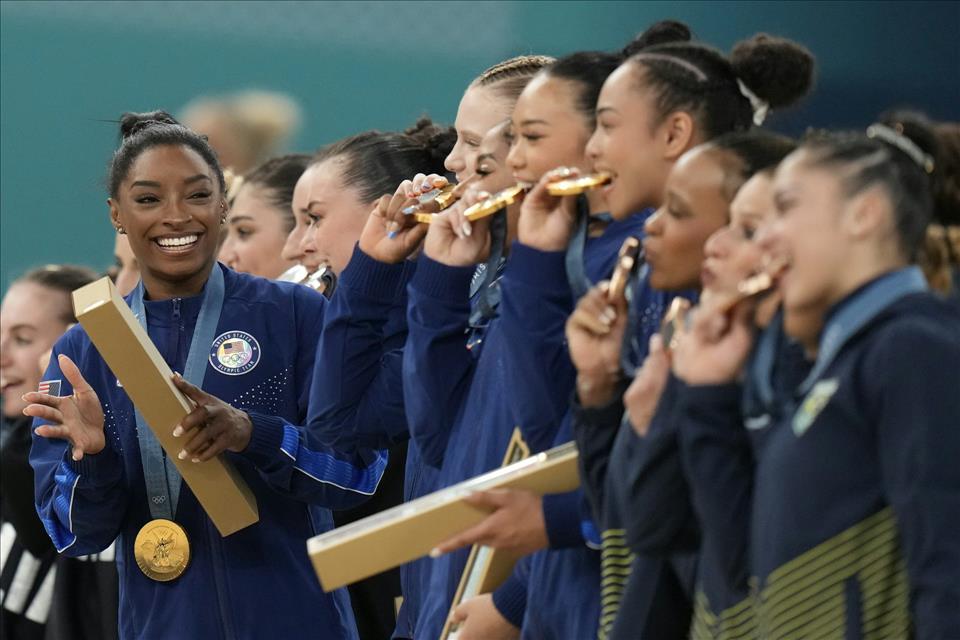
From 'Teenage Pixies' To A Grown Woman's Domain Olympic Gymnastics Is Finally Evolving For The Better
In fact, four of the five United States athletes who took team Gold in Paris were women in their 20s attending their second Olympics.
And after picking up the all-around gold , 27-year-old Simone Biles is the oldest winner in 72 years.
The last time a non-teenager took that title was in 1972. And even then, 20-year-old Soviet Ludmila Turischeva's win was upstaged by the electric performances of her younger teammate Olga Korbut, aged 17.
Korbut would be the first in a line of“teenage pixies” who emerged after the women's discipline took an acrobatic turn in the 1970s, favouring a smaller physiology and younger athletes.
The media, ever enamoured with prodigious children, fuelled an enduring cultural fascination with these gymnast wunderkinds.
Young athletes, big pressureGirls' acrobatic feats were often seen as charming play or superhuman acts , instead of the product of intense labour undertaken by children.
By the late 1990s, however, journalist Joan Ryan's book, Little Girls in Pretty Boxes, raised significant questions about the treatment and disposable careers of girls in gymnastics and figure skating.
In 1997, the International Gymnastics Federation (FIG) raised the minimum competitive age from 15 to 16 to protect girls' health.
Since then, developments in competition formats and training approaches resulted in longer careers.
Despite the gradual rise in the ages of gymnasts since the turn of the century, paternalist attitudes lingered both within and outside of the sport.
One study found coaches and officials were slow to stop viewing gymnasts as children. My own study observed how broadcasters often clung to the cute, disciplined girl-child as a gymnastics behavioural ideal well into the 2000s.
Contrary to this was a“diva” stereotype, used by reporters and commentators to describe athletes who defied the ideal.
Svetlana Khorkina , a hugely successful Russian gymnast who competed into her 20s, was labelled as such for her mercurial, outspoken personality.
In the 2024 Athens games, the 25-year-old was pitted against ponytailed teen Carly Patterson for Olympic gold. Some portrayed it as a battle between youthful zest and aged arrogance.
Later, world champion Aliya Mustafina and her teammates were similarly labelled for their self-assured and headstrong attitudes. These attributes were often treated as factors in losses or mistakes.
At the 2011 American Cup , when Mustafina made a competitive decision against her coach's advice that didn't work out, commentators treated it like a cautionary tale .
It was as if autonomy and self-possession were out of place in a sport for little girls.
Then, in 2016, came the sport's greatest reckoning.
A torrid history of abuseThe Larry Nassar sexual abuse case ignited waves of present and former gymnasts worldwide to speak out about the silencing, abuse and toxic training environments they'd endured.
Over the next few years, athletes recounted the cost of childhood sporting careers.
Coaches were investigated . Independent reviews were undertaken.
Australia, too, confronted its past. A former national coach was sanctioned .
An Australian Human Rights Commission review concluded a“win at all costs” culture created“unacceptable risks” to young athletes.
The national governing body, Gymnastics Australia, apologised to survivors of abuse.
Gymnastics Australia apologised to athletes who suffered abuse.
Age is by no means the only factor in vulnerability to abuse, but research shows that age and international-level training are significant risk factors in forms of interpersonal violence.
There are also child labor concerns, as well as health and wellbeing risks - something figure skating has been forced to grapple with following a doping case involving a 15-year-old at the Beijing Winter Olympics.
In this context, the newfound emergence of older gymnasts is reassuring. But what is more reassuring is that athletes are now being treated as adults.
A change in attitudeBefore the Paris games began, USA Gymnastics technical lead Chellsie Memmel told reporters Biles would have the option to not compete on every apparatus during the team competition.
“If that's what she needs to continue to be at her best for her team and for herself, then that's what we're going to do,” Memmel said of their highest scorer.
In 2021, Biles also chose to withdraw mid-competition during the Tokyo games for mental health and safety reasons.
Read more: How to win on your own terms: Simone Biles claims her eighth Olympic gold on her Paris 2024 'redemption tour'
For longtime gymnastics followers, the notion of gymnasts being able to decide how and when they compete is still alien and refreshing.
So too is gymnasts eating pizza (an act former US Olympian Aly Raisman once feared might cost her career) and making sideline TikToks in Paris.
It's a world removed from gymnastics' recent, oppressive past.
A seismic outcome of gymnastics' reckoning has been a culture change that appears to finally privilege autonomy. Choice may be becoming these athletes' new normal.
-
Gymnastics
Simone Biles
Larry Nassar
USA Gymnastics
Gymnastics Australia
2024 Paris Olympics
Gymnasts
Sport and Society

Legal Disclaimer:
MENAFN provides the information “as is” without warranty of any kind. We do not accept any responsibility or liability for the accuracy, content, images, videos, licenses, completeness, legality, or reliability of the information contained in this article. If you have any complaints or copyright issues related to this article, kindly contact the provider above.
Most popular stories
Market Research

- Manuka Honey Market Report 2024, Industry Growth, Size, Share, Top Compan...
- Modular Kitchen Market 2024, Industry Growth, Share, Size, Key Players An...
- Acrylamide Production Cost Analysis Report: A Comprehensive Assessment Of...
- Fish Sauce Market 2024, Industry Trends, Growth, Demand And Analysis Repo...
- Australia Foreign Exchange Market Size, Growth, Industry Demand And Forec...
- Cold Pressed Oil Market Trends 2024, Leading Companies Share, Size And Fo...
- Pasta Sauce Market 2024, Industry Growth, Share, Size, Key Players Analys...





















Comments
No comment